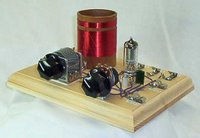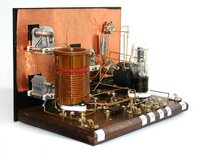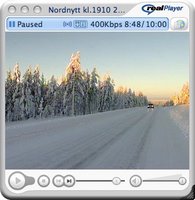
 Ascoltare le stazioni radio lontane può ancora fare notizia. A patto di essere sulla tv svedese. Se ci pensiamo bene, farsi un due, tremila chilometri, di cui seicento in mezzo al permafrost, per chiudersi in un cottage in legno a quindici gradi sottozero solo per sentire le Hawaii in onde medie può sembrare un'impresa un po' pazzerella, di quelle che sembrerebbero divertenti anche ai nostri tiggì regionali. Comunque sia, i nostri colleghi Alessandro Groppazzi, Valter Comuzzi, Francesco Clemente e Elio Fior, friuliani e giuliani, sono finiti sul telegiornale regionale del nord della Svezia. Gli inviati dell'emittente hanno loro chiesto che cosa ci stessero facendo nella remota località della Lapponia svedese, Parkalompolo. E la risposta è semplice: stiamo ascoltando la radio! In inglese con sottotitoli in svedese Alessandro ammette anche che se la famiglia ha ormai dovuto rassegnarsi davanti a certe manifestazioni "estreme" del suo hobby, gli amici lo ritengono matto.
Ascoltare le stazioni radio lontane può ancora fare notizia. A patto di essere sulla tv svedese. Se ci pensiamo bene, farsi un due, tremila chilometri, di cui seicento in mezzo al permafrost, per chiudersi in un cottage in legno a quindici gradi sottozero solo per sentire le Hawaii in onde medie può sembrare un'impresa un po' pazzerella, di quelle che sembrerebbero divertenti anche ai nostri tiggì regionali. Comunque sia, i nostri colleghi Alessandro Groppazzi, Valter Comuzzi, Francesco Clemente e Elio Fior, friuliani e giuliani, sono finiti sul telegiornale regionale del nord della Svezia. Gli inviati dell'emittente hanno loro chiesto che cosa ci stessero facendo nella remota località della Lapponia svedese, Parkalompolo. E la risposta è semplice: stiamo ascoltando la radio! In inglese con sottotitoli in svedese Alessandro ammette anche che se la famiglia ha ormai dovuto rassegnarsi davanti a certe manifestazioni "estreme" del suo hobby, gli amici lo ritengono matto.In realtà non c'è bisogno di sottoporsi a certi tour de force per fare del DX. Ma per una volta o due si può fare. Un po' perché in Lapponia, dove di inverno non c'è praticamente insolazione, si possono sentire cose che qui da noi sono semplicemente impossibili (tipo il Pacifico in onde medie). E poi perché solo in Lapponia ormai si trovano le condizioni ideali: basso rumore elettrico e spazio virtualmente infinito per il montaggio di antenne filare lunghe anche mille, millecinquecento metri.
I DXer italiani si stanno abituando alle DXpedition. Con l'amico Renato Bruni sono stato già un paio di volte a Muhos, nei pressi di Oulu, nord della Finlandia, dove l'amico Jari Ruohomäki ci ha ospitato nel suo cottage nella foresta. Un cottage circondato da sette o otto antenne da almeno ottocento metri. La prima volta non eravamo stati fortunati con le condizioni propagative, la seconda, lo scorso dicembre, le cose sono andate molto meglio.
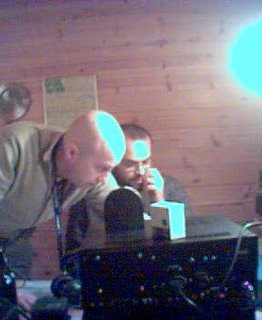 I risultati sono stati appena pubblicati sul sito Radioascolto.org. Ancora meglio sembra siano andate le cose ai nostri amici di Parkalompolo, perché la seconda metà di gennaio è stata davvero fantastica nel nord Europa (molto meno qui al Sud) e anche grazie alla presenza di più persone.
I risultati sono stati appena pubblicati sul sito Radioascolto.org. Ancora meglio sembra siano andate le cose ai nostri amici di Parkalompolo, perché la seconda metà di gennaio è stata davvero fantastica nel nord Europa (molto meno qui al Sud) e anche grazie alla presenza di più persone.  Quando il DX può essere fatto letteralmente nell'arco delle 24 ore, è essenziale poter presenziare davanti a una radio e al tempo stesso prendersi qualche ora di sonno. In Lapponia è difficile scegliere il momento giusto per andare a dormire. Quando qui ci si alza per lavorare arrivano sulle onde medie le stazioni del Messico, della California, fino alle dieci, undici del mattino, quando si può cominciare a provare il Pacifico. Le Hawaii arrivano a mezzogiorno. Poi verso le 13 comincia ad arrivare il Giappone e si va avanti fino alle 16, le 17 quando si può provare l'India. A quel punto se si e' veramente a nord, dopo le 18 si può già cominciare a sperare per l'Alaska o magari per l'Australia. Si tira fino alle 20 quando il Canada è già bello forte, o alle 21, quando si può tranquillamente scommettere su una bella daytimer (le stazioni che chiudono al tramonto) del Midwest. Poi liberi tutti dal Canada al Cile e alle sette del mattino successivo si ricomincia.
Quando il DX può essere fatto letteralmente nell'arco delle 24 ore, è essenziale poter presenziare davanti a una radio e al tempo stesso prendersi qualche ora di sonno. In Lapponia è difficile scegliere il momento giusto per andare a dormire. Quando qui ci si alza per lavorare arrivano sulle onde medie le stazioni del Messico, della California, fino alle dieci, undici del mattino, quando si può cominciare a provare il Pacifico. Le Hawaii arrivano a mezzogiorno. Poi verso le 13 comincia ad arrivare il Giappone e si va avanti fino alle 16, le 17 quando si può provare l'India. A quel punto se si e' veramente a nord, dopo le 18 si può già cominciare a sperare per l'Alaska o magari per l'Australia. Si tira fino alle 20 quando il Canada è già bello forte, o alle 21, quando si può tranquillamente scommettere su una bella daytimer (le stazioni che chiudono al tramonto) del Midwest. Poi liberi tutti dal Canada al Cile e alle sette del mattino successivo si ricomincia.Le località veramente mitiche per le DXpedition europee sono due, Lemmenjoki in Finlandia e Kongsfjord in Norvegia, la più settentrionale di tutte.
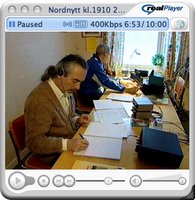 Parkalompolo è un po' più a sud, ma non scherza affatto. Finora solo Lemmenjoki era finita in televisione, addirittura su CNN (il filmato si può ancora vedere sul sito qui linkato, l'autore è il giornalista della tv finalndese YLE, veterano di Lemmenjoki, Mika Mäkeläinen). Alessandro, Francesco, Valter, Elio e i padroni di casa svedesi Stefan Wikander e Sigvard Andersson sono ottimi secondi.
Parkalompolo è un po' più a sud, ma non scherza affatto. Finora solo Lemmenjoki era finita in televisione, addirittura su CNN (il filmato si può ancora vedere sul sito qui linkato, l'autore è il giornalista della tv finalndese YLE, veterano di Lemmenjoki, Mika Mäkeläinen). Alessandro, Francesco, Valter, Elio e i padroni di casa svedesi Stefan Wikander e Sigvard Andersson sono ottimi secondi. 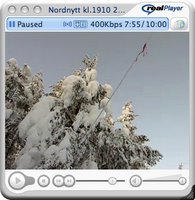 Il loro imperdibile show, trasmesso il 31 gennaio, si trova sul sito di SVT. Un altro posto interessante si trova in Danimarca a Fjerritslev, nello Jutland del nord. Il proprietario della villa, l'editore tedesco Wilhelm Herbst, mette a disposizione dei colleghi una struttura molto interessante, con antenne destinate anche all'FM-DX per i mesi estivi. E in Italia? Purtroppo gli spazi, le case, i rumori elettrici non offrono molte situazioni ideali, ma prima o poi riusciremo a trovare un luogo adatto, anche senza tutto quel ghiaccio.
Il loro imperdibile show, trasmesso il 31 gennaio, si trova sul sito di SVT. Un altro posto interessante si trova in Danimarca a Fjerritslev, nello Jutland del nord. Il proprietario della villa, l'editore tedesco Wilhelm Herbst, mette a disposizione dei colleghi una struttura molto interessante, con antenne destinate anche all'FM-DX per i mesi estivi. E in Italia? Purtroppo gli spazi, le case, i rumori elettrici non offrono molte situazioni ideali, ma prima o poi riusciremo a trovare un luogo adatto, anche senza tutto quel ghiaccio.Tags: radioascolto, radiofonia, radio, dxing.
